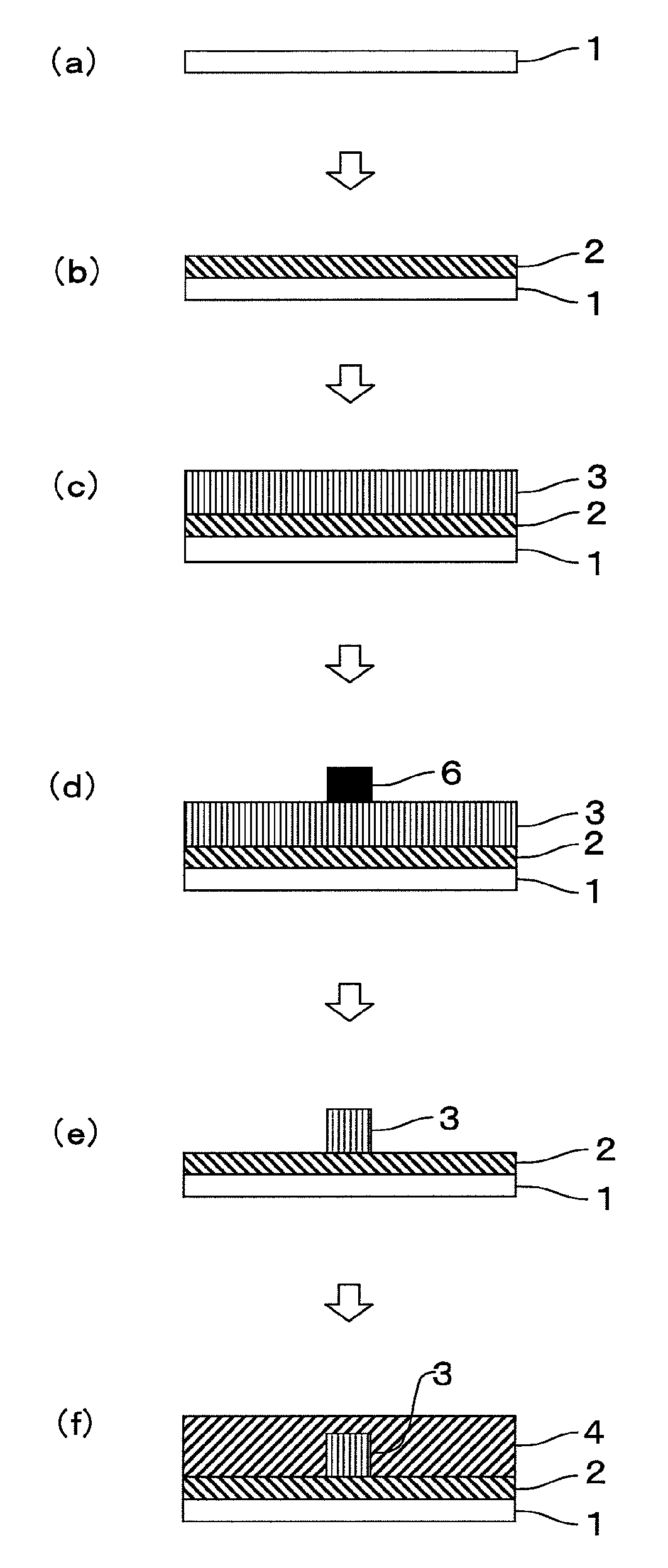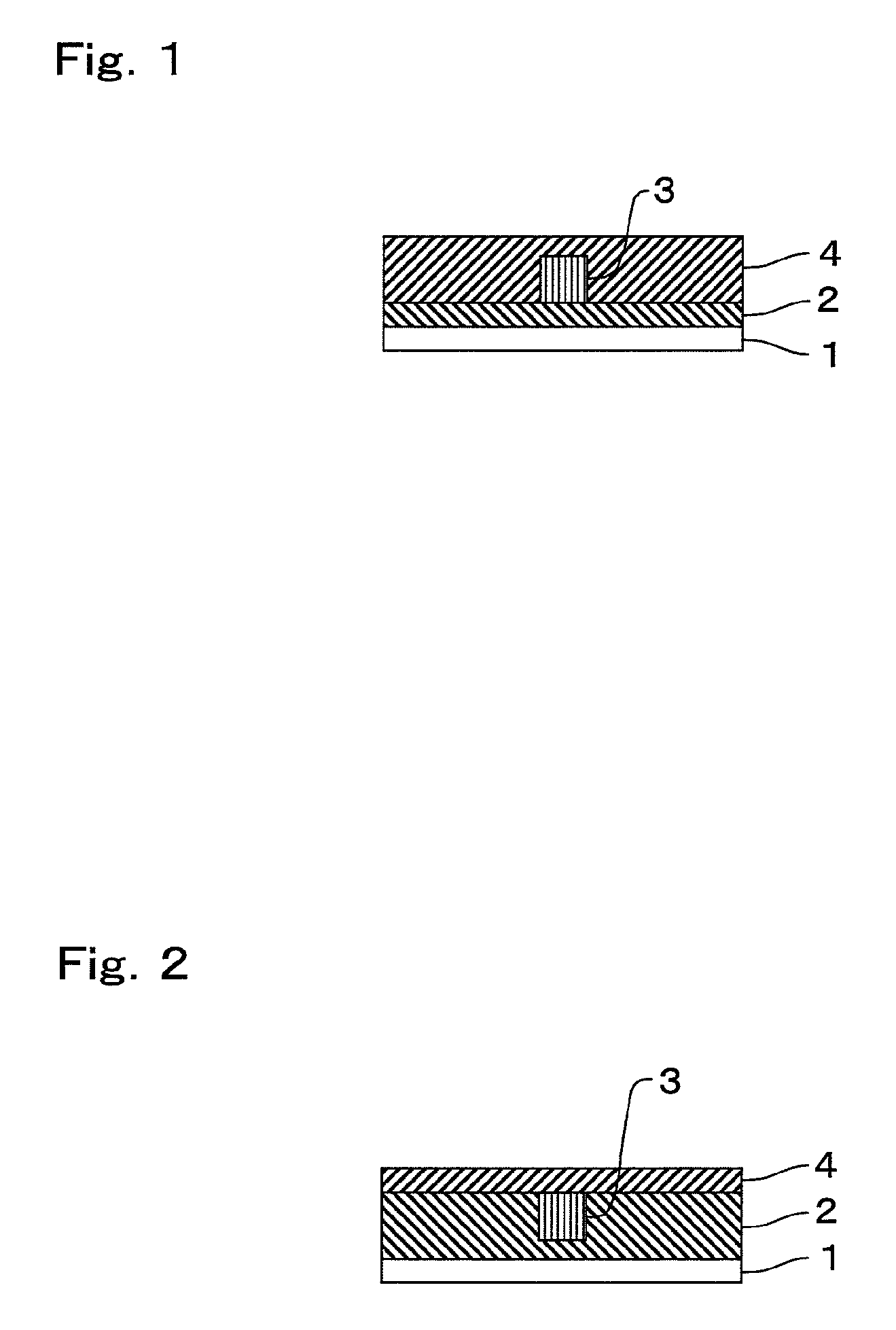Flexible optical waveguide and process for its production
a technology process, applied in the field of flexible optical waveguides, can solve the problems of complex production steps and high production costs, and achieve the effects of excellent flexibility and heat resistance, excellent peel strength, and high adhesiveness
- Summary
- Abstract
- Description
- Claims
- Application Information
AI Technical Summary
Benefits of technology
Problems solved by technology
Method used
Image
Examples
example 1
[0116]A polyimide film with a 8-μm thick copper circuit (product name: Kapton (registered trade name) H type, available from DuPont-Toray Co., Ltd.; the thickness thereof was 25 μm) was used as a substrate, and a surface of the substrate, which surface was reverse to the copper circuit, was subjected to physical treatment with a #3000 whetstone to form unevenness (the arithmetic average roughness (Ra) thereof was 0.08 μm) thereon.
[0117]The UV-curable epoxy resin (1) was coated as a cladding material on the surface of the substrate by spin coating technique and cured by carrying out ultraviolet irradiation at an illumination intensity of 10 mW / cm2 for 15 minutes, i.e., at an exposure energy of 9 J / cm2, by the use of an exposure apparatus (product name: MA-60F, available from Mikasa Co., Ltd.) with a high pressure mercury lamp as a light source to form a lower cladding layer composed of an epoxy type resin film having a thickness of 25 μm.
[0118]At this stage, peel strength between the...
example 2
[0123]A flexible optical waveguide having a lower cladding layer, a core layer, and an upper cladding layer, all of which were composed of epoxy type resin films, on a substrate of a polyimide film was obtained in the same manner as described in Example 1, except that the #3000 whetstone was changed to a #6000 whetstone to form unevenness (the arithmetic average roughness (Ra) thereof was 0.06 μm) on a surface of the substrate, which surface was reverse to the copper circuit.
[0124]At the stage where the lower cladding layer was formed on the substrate, peel strength between the substrate and the lower cladding layer was measured using a tensile tester (product name: EZ-test-100N, available from Shimadzu Corporation) according to JIS K6894 8.6.3 and found to be 170 N / m, and it showed excellent adhesiveness.
[0125]When the waveguide loss of a flexible optical waveguide obtained in the same manner as described above was measured, it was 0.15 dB / cm. Further, even if a flexible optical wa...
example 3
[0126]A flexible optical waveguide having a lower cladding layer, a core layer, and an upper cladding layer, all of which were composed of epoxy type resin films, on a substrate composed of a polyimide film was obtained in the same manner as in Example 1, except that the #3000 whetstone was changed to a #8000 whetstone to form unevenness (the arithmetic average roughness (Ra) thereof was 0.05 μm) on a surface of the substrate, which surface was reverse to the copper circuit.
[0127]At the stage where the lower cladding layer was formed on the substrate, peel strength between the substrate and the lower cladding layer was measured using a tensile tester (product name: EZ-test-100N, available from Shimadzu Corporation) according to JIS K6894 8.6.3 and found to be 140 N / m, and it showed excellent adhesiveness.
[0128]When the waveguide loss of a flexible optical waveguide obtained in the same manner as described above was measured in the same manner, it was 0.15 dB / cm. Furthermore, even if...
PUM
| Property | Measurement | Unit |
|---|---|---|
| Ra | aaaaa | aaaaa |
| peel strength | aaaaa | aaaaa |
| Ra | aaaaa | aaaaa |
Abstract
Description
Claims
Application Information
 Login to View More
Login to View More - R&D
- Intellectual Property
- Life Sciences
- Materials
- Tech Scout
- Unparalleled Data Quality
- Higher Quality Content
- 60% Fewer Hallucinations
Browse by: Latest US Patents, China's latest patents, Technical Efficacy Thesaurus, Application Domain, Technology Topic, Popular Technical Reports.
© 2025 PatSnap. All rights reserved.Legal|Privacy policy|Modern Slavery Act Transparency Statement|Sitemap|About US| Contact US: help@patsnap.com



